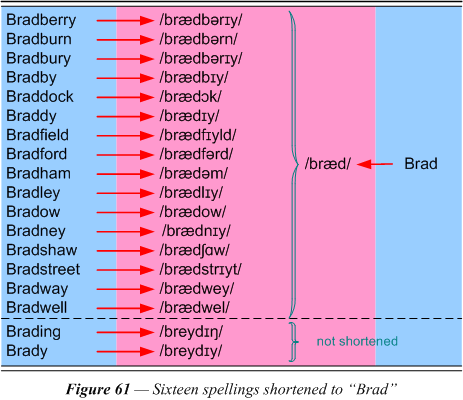
5.6 Hypocoristic derivation. (H) The formation of pet names, which in America are loosely called nicknames and in France are hypocorisms, was originally developed for the purpose of having a form of a name to use in familiar circumstances. These names are usually derived from the more formal or official form of the name by some systematic alteration or the addition of certain affixes. People do not have to be literate to invent pet names, but these name do acquire regular spellings. Such a derived spelling was therefore at first a variant form, but over time some of them have come to be considered names in their own right. Hypocorisms may be divided into two classes: those that are formed by 1) altering the pronunciation of the full form of the name in certain regular ways (phonological alteration), and 2) attaching a particular derivational suffix (possibly a prefix or infix), which usually has a diminutive meaning, to the full form of the name (morphological affixation).
Figure 60 illustrates examples of hypocorisms for a couple of common English given names. Like most polysyllabic names, David may be shortened to the first syllable. The single syllable thus left may in some cases serve as a simple hypocorism, as it is with Dave. Abigail serves as an example of a name where procope leaves us with just the last syllable. In this case, however, the single syllable left by truncation, “*Abb,” cannot serve as a hypocorism by itself. The short form, whether or not in use, becomes the stem to which the diminutive suffix is added, thus marking it specifically as a hypocorism. In the case of Abigail, the procope may be respelled as Gale, homophonic with the word for a storm at sea. The distinctive spelling seems to show that this particular name is not the same name as Abigail, but is meant to be separate and distinct. However, it would seem that possible confusion about the spelling of the two names could justify the two being grouped together, provided Gail is indeed felt still to be a pet form of Abigail.

In other words, the name Gale and any of its variants could be grouped wholely within the name Abigail and its variants since these standard spellings seem to have no distance between them. It is possible that the functions that form hypocorisms do not produce any appreciable distance between them and the formal spelling from which they derive. The operations involved may assign a negligible if any score to the changes executed in the chain at this level.
Paradoxically, it is possible that equivalent spellings can exhibit some distance from each other. As mentioned in regard to orthographic abbreviation, hypocorism exhibits several ways that spellings are shortened. The processes of truncation, procope, syncope, etc., typically occur with the phonological form of a name, where they are called clipping. These processes are often involved in the process of invention of a new name, but in hypocorism they are intended to produce a variant of the same name. For people who have been christened with certain surnames for their given name, the shortening seems to come quite naturally. A good number of possibilities for the origin of the name “Brad” are listed in figure 61. The last two spellings listed should make it clear that it is not the spelling that is central to the process; these last two spellings do not have the requisite pronunciations to participate in hypocoristic shortening.

The main point to be made here is that given the spelling Brad, there is really no way to determine, without information about the individual carrying the name, the full form of the name from which it derives, or whether, indeed, it is even felt to derive from some particular unclipped form. This may be some justification for organizing the above surnames, when used as different given names, into one name group. There is a degree of leveling that has taken place among them, so that the distance between them, as given name variants, cannot be measured indirectly. They are all equivalent to Brad, but their actual spellings, each being quite different, all lie at some non-zero edit-distance from each other.
